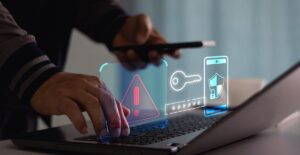
Why Multi-Factor Authentication (MFA) is Essential for Security
When it comes to cyber security, there’s one fact that always makes organisations sit up and pay attention: the vast majority of compromised accounts aren’t protected with multi-factor authentication (MFA). In fact, Microsoft found that more than 99.9% of compromised accounts don’t have MFA enabled.
Despite this, many businesses still rely on passwords alone, leaving the digital front door wide open for attackers. Weak or stolen passwords remain the number one entry point for hackers, and the fallout can be costly; financially, reputationally, and operationally.
MFA is now a critical safeguard that every organisation, big or small, should be implementing. The good news is that, when done right, rolling out MFA doesn’t have to be complex or disruptive.
Passwords Alone Aren’t Enough
Passwords were never designed to carry the full weight of modern cyber security. They’re easy to guess, easy to reuse, and all too easy to steal. Millions of credentials circulate on the dark web every year, harvested through phishing scams and data breaches. And because people often recycle the same password across multiple accounts, one leaked password can open the door to an entire organisation. According to Verizon’s 2025 Data Breach Investigations Report, around 88% of breaches involving web applications used stolen credentials.
This is why MFA has become essential. Without it, businesses are effectively handing attackers the keys to the kingdom.
What MFA Actually Does
Multi-factor authentication works by asking for more than one piece of evidence before granting access. It could be something you know (like a password), something you have (such as an authentication app or a physical token), or something you are (like a fingerprint).
The idea is that even if a criminal steals your password, they still can’t log in without that extra factor. Some employees might push back, thinking it slows them down or is complicated, but today’s MFA tools are designed to be quick and painless. Approving a login notification on your phone takes seconds. Biometric authentication can be even faster. MFA removes a huge part of the risk to your organisation.
How to Roll Out MFA Painlessly
The smartest approach is to start small and build momentum. Protect your highest-risk accounts first—administrators, executives, or anyone with privileged access. Once those accounts are locked down, expand MFA to other systems and users.
It helps to make app-based authentication the default option. Codes sent by text message are better than nothing, but authenticator apps and biometric approvals are far more secure and user-friendly.
Communication is equally important. Employees are more likely to adopt MFA if they understand why it matters. Avoid jargon and explain the risks in real terms: one weak password could expose sensitive data or leave the company unable to operate. Provide checklists, short explainer videos, and visual reminders to make adoption smoother.
With the right plan, MFA can become second nature across the business, rather than a box-ticking exercise.
The Wider Value of MFA
MFA isn’t just another security tool; it strengthens compliance with frameworks such as GDPR and ISO 27001. Implementing MFA shows you take your obligations seriously.
MFA also builds trust. Clients and partners want reassurance that their data is safe. Using MFA demonstrates proactivity and commitment to security.
Importantly, it shapes culture. When employees see MFA as standard, it reinforces that security isn’t optional, improving awareness in phishing recognition and responsible data handling.
Making MFA Stick
Security measures only work when people actually use them. That’s where our Secure Our World Toolkit can help. It includes posters, screensavers, checklists, and infographics that guide employees through setting up MFA and explain best practices.
Working with MetaCompliance
Now is the time to make MFA standard practice in your business. Begin by enabling it on high-risk accounts, use the CSAM checklist and toolkit to guide your rollout, and make sure leadership leads by example. These steps help close the door on the most common attacks and give employees and clients confidence that data is protected.
Get in touch with our team today to find out how we can support your MFA journey.
Multi-Factor Authentication (MFA) FAQs
What is multi-factor authentication (MFA)?
MFA is a security method that requires users to provide two or more forms of verification before accessing an account, such as a password plus a code from an app or a fingerprint.
Can MFA prevent stolen password attacks?
Yes. Even if a password is stolen, MFA prevents unauthorised access because the attacker would still need the second factor to log in.
Which MFA methods are the most secure?
Authenticator apps, hardware tokens, and biometric verification are more secure than SMS codes, which can be intercepted.
Does MFA help with compliance and regulations?
Yes. Many frameworks, including GDPR and ISO 27001, recommend MFA as part of good security practice.